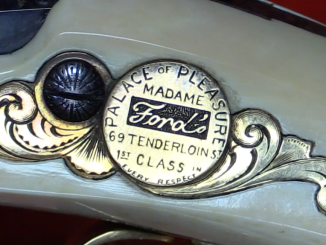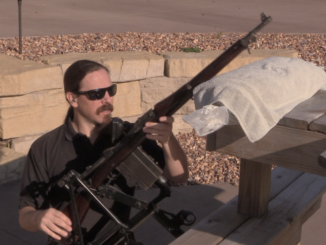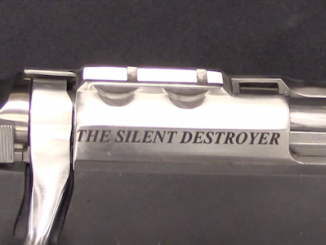A question I have been asked by several different people in several Q&A threads is:
“Does the Savage rotating-barrel system actually do anything?”
In his 1905 patent, Elbert Searle specifically claims that his design creates a positively locked breech. He did this, in theory, by having a system where the barrel must rotate before the slide can move rearward (which opens the breech), and where the bullet engaging the rifling created an opposite rotation which would hold the breech closed until the bullet left the barrel.
In reality, Searle’s system does not do that. The breech begins to open while the bullet is still traveling down the barrel, as the rearward pressure on the breech substantially overmatches the rotations force created by the bullet on the rifling. However, this system does still provide some delay, and allows the moving parts of the Savage system to be about 20% lighter in mass than those of the Browning model 1900. The Savage may not have a positively locked breech, but it is a safe and reliable design.




Looks like an interesting system, wonder why this hasn’t been replicated or reiterated upon nowadays?
Because nowadays you can get a reasonably inexpensive, fully locked breech .32 pistol that weighs less than the Savage’s slide.
The French MAB PA-15, in 9mm Parabellum, used the same system.
The main “problem” is that, for the same complexity, you can do a really locked breech rotating barrel action. That also has the advantage to suck a lot of felt recoil.
Infact, between a rotating barrel locked breech and the Savage dealyed recoil, the only thing that differs is the inclination of the slots in the frame and in the slide.
45° slot in the slide, 90° slot in the frame = Savage delayed blowback.
90° slot in the slide, 45° slot in the frame = rotating barrel locked breech.
Mind that you can also make an hybrid system.
45° slot in the slide, 45°slot in the frame = delayed blowback that’s MORE delayed than the Savage action (because not only the barrel is delayed in rotating by the momentum of the bullet, but also has to recoil at half the speed of the slide).
The last one would be a very interesting design, especially for high-pressure high-speed bottleneck cartridges, like the 5.7×28mm, that seems to prefer those kind of higly delayed blowback actions (infact, the pistols that shoot it, use the Revelli rotating lock).
The claim of the patent was quite absurd from the start.
Had the parts still been completely locked, the moment the bullet left the barrel and the pressure dropped to safe level. Then there would have ben NOTHING LEFT to open the action afterward.
If the slide is the only moving part, then the slide must start moving before the bullet leaves the barrel, to have enough residual kinetic energy to complete (ore even to begin) the cycle. It’s not like the pistol can store energy somewere.
On the other hand, the momentum of the recoil (equal and opposite to the one that pushes the bullet forward) MUST be MUCH stronger than the one that makes the bullet rotate (and so, for reaction, the locking one) otherwise the bullet will never leave the barrel. So that momentum can’t, in any case, lock the action.
I agree with the first paragraph; (e.i. nothing would move the action afterwards) very true statement.
I also believe the barrel bore twist has an important role in the whole equation. The only question left out is to what degree the design is optimized and what (if any) reserve it has built into it. I feel not much. But I also assume that the designer gave it enough effort to bring it into the form as it is now.
I believe the center issue here is wording as introduced in the patent description. The originator perhaps wanted to add a sense of “safety” to the pistol. In reality though the pistol works just fine as it is designed. Sure, there is a puff at the muzzle and the breech commences to move at the same time. There is nothing wrong with that as long as pressure in the barrel is contained. The usual blow back system is not doing anything than that.
Having this wonderful tool at hand and seeing what is happening could lead perhaps to increase of Slide mass. Then of course it would raise an issue IF and at what amount of such increase it would still work reliably. At that point the barrel length could be increased as well. I think this should be a fantastic project for anyone who wants to take on it.
Besides of this pistol there is another very similar French design, I cannot get its designation from top of my head; is it not M1935? What is its record as far as reliability and safety? What is its breech mass? It would be nice if Ian took it one step further and took close look at it too.
It’s the MAB PA-15 in 9mm Parabellum.
Don’t know the weight of the slide alone, but at 1.09 kg unloaded, it was pretty heavy for a sigle-stack steel-framed 9mm.
The PA-15 derived its designation from its double-column 15-shot magazine.
The single-stack 8-shot version was the PA-8.
Both were “substitute standard” pistols with the French military from the 1960s to the 1980s, along with the Manhurin P1 (Walther P.38).
In 1988 the French military and police adopted the Beretta M92FS, aka the U.S. M9, as the universal standard sidearm.
cheers
eon
“Manhurin P1”
It is Manurhin (Rhin is français name for river Rhenus).
Who is behind hoax that name is ending with hurin?
Common transposition error among Anglophones who see Manurhin in print but do not hear it spoken.
“(…)Savage may not have a positively locked breech, but it is a safe and reliable design.”
This leads to another question: how Searle was able to provided that if he had not idea how automatic pistol designed by him actually worked? Just by chance? Also why they did not run simple test: just use smooth barrel?
The final design is a result of considerable amount of experimentation; this is common right across the industry. I almost never entails in first drawing to final product directly.
If possible… Same experiment should be made with “MAP PA15” which works in the same principle…
On the other hand… 200 grams of slide weight seems more than enough for a .32 ACP round which recoils only 1,9mm with a barrel length of approx. 10 cm as remaining optimum blowback distance for a .32 case in unsupported form at the back.
IMHO…
Yes, the MAB PA15 is the one I meant; it works much the same as the Savage 1907. Also you reasoning is sound IMO.
As long as the initial breech opening is not in excess of thick cartridge bottom/ base, all should work out.
An auto loading firearm cycles under the effects of; Gained momentum and residual gas after the bullet leaving the bore…
Even the recoil in the holding hand gives some momentum to the gun even if the slide remains unmoved and there it comes the residual gas… These two factor may give enough energy for gun cycling…
Besides…
Savage pistol has removable barrel and breechbolt and its moving tolerances… They also may give supporting energy for slide initial backward momentum…
Further…
Savage breechbolt removes through a rotating movement and obturating case in the chamber with swaged back over the breech face may give some initial rotating motion for the barrel resulting early lock out…
Therefore…
A PA15 pistol would give much correct ideas about unmoving rotating barrel lock plus its higher rotation work.
IMHO.
The portion of PA15 function description in wiki says:
“When the pistol is fired, the rotational inertia of the barrel, the bullet torque and the slide’s linear inertia (leveraged through the cam track) all act against the opening force of the cartridge.” Basically same as Savage.
It is notable that its barrel is 20mm longer than that of Savage 45.
https://en.wikipedia.org/wiki/MAB_PA-15_pistol
Probably best not put too much faith in the comparison with the weight of the Browning 1900s slide
We don’t know without doing the measurements on a Browning 1900, where about in the operating envelope, Browning was aiming for
The heavier slide may have been for greater reliability of feeding and chambering, rather than to prevent cases from ballooning and popping.
It may be that a browning will operate safely with a slide that is 20% lighter than it presently is.
I don’t have figures for barrel length or the weight of the bullet and powder charge of either pistol
It would probably be interesting to calculate what the slide travel would have been with pure blowback operation, and compare that with measurements from your high speed vids, to determine what delay the rotating barrel actually gives.
The Savage Rotating Barrel is right on the shelf next to the Blish Lock.
Can’t really blame the poor guy… Searle hardly had access to the tools he needed to actually observe what his design was doing, in real time. I suspect that much of what he came up with for that patent was pure conjecture on his part, backed up by what he thought was experimental evidence.
On the other hand… What ammo was this pistol designed around? Was it, perhaps, pure lead for a projectile, which would presumably be more “sticky” in terms of creating torsional energy along the rifling? Or, would that even make a difference?
I suspect there’s an equation out there that would tell you how much energy was applied to the rifling, and how much resistance that would create for the barrel rotating in the opposite direction to unlock, and that you could likely find a difference between the various projectile materials.
My take on the issue would be that the proposition that there’s enough energy in that barrel rifling/projectile interaction is highly questionable, and that there simply isn’t enough there to actually do much in the way of “locking” an action like this.
I mean, seriously… If there were enough, would you not feel significant torsion when you fired a single-shot pistol or a revolver? I cannot recall ever feeling significant torsion from firing anything at all, even a machinegun or something in a magnum-class single-shot pistol. If there were enough energy there to be had, I strongly suspect you’d be feeling the weapon twist around as you held it while firing.
Not to mention… Think about the masses involved: A projectile for a .380 weighs roughly 6 grams. The rifling is applying how much friction to that, and how much energy is being siphoned off to lock the mechanism of the slide/barrel, that weighs how much? The best guess I can make is that the slide and barrel probably weigh around 150-200 grams, and the idea that you’re going to keep those together under the pressure of firing a .380 cartridge through the sole office of the frictional energy imparted on the barrel by the projectile that weighs in at 6 grams? Ludicrous, on the face of it.
I’d love to know why on Earth Searle thought this was actually a “thing”, and how the patent even got approved. Ball-park math makes me question it, even without Ian’s high-speed video evidence.
Then again, they did approve the Blish patent, as someone else notes.
It’s pretty simple.
The angular momentum the projectile imparts to the barrel is equal and opposite to the angular momentum the barrel imparts to the projectile.
the recoiling momentum of the slide is equal and opposite to the momentum of the projectile.
If the projectile imparts to the barrel an angular momentum so big to stop the slide from recoiling, then the same projectile is not propelled with enough force to start rotating and exit from the barrel.
If projectile and slide are propelled by the same force, and subject to the same resistance, if the slide is locked, the bullet is locked too.
In reality, in small arms, a negligible fraction of the energy of the bullet is absorbed by the friction in the barrel. So the effect of the projectile’s momentum in locking the action is negligible.
What really causes the delay is that the inertia of the mass of the barrel is added (altough no 1/1) to that of the slide, infact, for the slide to recoil, the barrel must rotate, so the slide AND the barrel must accelerate from their state of stillness.
A very convincing analysis of the factors involved. Thank you.
There’s noticeable torsion with a Fosbery, but that’s from the turning cylinder not the turning bullet.
Hogg & Weeks, in the Savage entry in their “Pistols of the World,” notes: “… spark-gap photographs made in Germany in the late 1920’s … apparently revealed that the breech of the 7.65mm Savage actually opened faster than that of a 6.35mm Baby Browning, a pure blowback.” They finish the paragraph with; “We incline to the view that the Savage was a delayed blowback, in effect, if not in intention.” Now that we have really high-speed video available, the contention is proven. I never thought of slide weight, though, as a justification for the Searle system. Thanks to Mr. M. for this experiment and this insight.
By the way: get a copper, aluminum or plastic rod what fits the bore of the Savage 1907’s barrel. Lead it through the bore to the breech face. Push the breech face with the rod.
If the slide would moving, it is a delayed blowback pistol.
If the slide cannot moving… Wait! The problem with this low tech experiment is that, nothing is rotate the barrel.
But this experiment can show that, the barrel rotating effect of the bullet is significant in the operation, or not.